460 Rowland Handload Data (For the impatient)
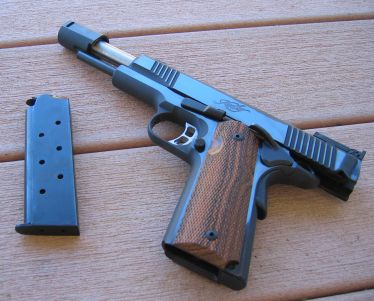 Interesting day at the range. The Kimber still has the intended number of pieces, the mainspring housing checkering pattern is tattooed permanently into the palm of my shooting hand and I can now almost open the slide without help from another adult. All and all, lots of fun.
Interesting day at the range. The Kimber still has the intended number of pieces, the mainspring housing checkering pattern is tattooed permanently into the palm of my shooting hand and I can now almost open the slide without help from another adult. All and all, lots of fun.
There were no mechanical problems with the Clark conversion and the combination was exceptionally accurate and predictable. Unless you are one of those whining metro-sexuals who needs a 45 GAP Glock to protect your piano playing hands, this is an easy gun to shoot. In fact, If it didn’t have recoil, it wouldn’t be worth shooting. Some of the handloads seemed very practical, others a bit more…spectacular.
A One Item Wish List
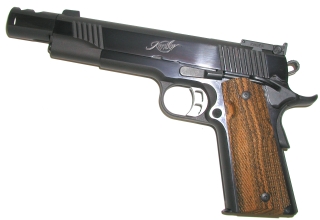 It would be great, If Clark Custom Guns would include a slip sheet with each kit that explained how to check, in a very basic way, if an installation went OK or if, because of dimensional variations in gun and parts, further attention from a gunsmith would be required. A gun owner with decent mechanical skills and reading comprehension, should be able to understand down and dirty techniques for checking top lug engagement and firing pin centering, checking for barrel spring and probably proper hood length and fit. Then, if the this checkout uncovered a problem, it would be time to turn the gun over to a gunsmith, or send it to Clark for fitting. The problem with the notation “may require minor fitting” is that the installer may not have enough knowledge or information to make that determination. I am sure product liability and protection from the members of the public that drink and attempt to shave with a circular saw is at the base of the notation, however, providing a little more information may further reduce the exposure. I do not believe, under any circumstance, Clark should attempt to provide instructions for corrective action. as this type of work is well beyond the capability of all but the trained and skilled. Again, I encountered no problems with the installation of the kit, it really was a drop in, this is a wish list item.
It would be great, If Clark Custom Guns would include a slip sheet with each kit that explained how to check, in a very basic way, if an installation went OK or if, because of dimensional variations in gun and parts, further attention from a gunsmith would be required. A gun owner with decent mechanical skills and reading comprehension, should be able to understand down and dirty techniques for checking top lug engagement and firing pin centering, checking for barrel spring and probably proper hood length and fit. Then, if the this checkout uncovered a problem, it would be time to turn the gun over to a gunsmith, or send it to Clark for fitting. The problem with the notation “may require minor fitting” is that the installer may not have enough knowledge or information to make that determination. I am sure product liability and protection from the members of the public that drink and attempt to shave with a circular saw is at the base of the notation, however, providing a little more information may further reduce the exposure. I do not believe, under any circumstance, Clark should attempt to provide instructions for corrective action. as this type of work is well beyond the capability of all but the trained and skilled. Again, I encountered no problems with the installation of the kit, it really was a drop in, this is a wish list item.
Handload Detail and Copious Notes

The task of assembling handloads for the 460 Rowland is very straight forward, with one caveat; with each increment in maximum average pressure in these hyper 45 autoloader rounds; 45 ACP 21,000 PSI, +P 23,000 PSI, 45 Super 28,000 PSI, and 460 Rowland 38,000+ PSI comes a disproportionate narrowing of margin for error. There is a substantial difference between bumping up a couple of tenths of a grain at the low end of the pressure spectrum and doing the same at the high end, as the high end is operating closer to the limits of the 1911 design.
The maximum overall cartridge length of a 460 Rowland is the same as all of the other .45 ACP based cartridges noted above, 1.275″. As a result, the heel of the bullet resides at the same relative distance from the case interior web, and therefore offers no greater capacity. The extra case length is intended to prevent the aforementioned circular saw shaver from inserting a 460 Rowland round into his favorite plastic framed auto. As a byproduct of my need to state and restate the obvious, small capacity cases used in short barrel guns best utilize fairly fast powder. In this regard, the Rowland cartridge is no exception. On the plus side of the ledger, small capacity means lots of handloads out of a pound of powder, on the negative side, even a couple of tenths of grains in powder charge variations can result in a significant swing in pressure. After reviewing a group of what seemed suitable powders and some published load data, I settled on four powders for this exercise: Alliant’s Power Pistol, Accurate #7, Hodgdon Long Shot, and Ram Shot True Blue. Other powders either seemed too slow and require heavier charges which would have resulted in excessive unburned powder, or too fast and too unforgiving in load graduations.
Between weighing, reworking to size, measuring all components, and eating a really tasty KFC lunch, it took 10 hours to load and document test ammo. Every charge was scale weighed, cases were trimmed to uniform length and bullets were selected with less than a 1/10th grain in weight variation within a weight group. After this lot of ammo was completed, I cranked out a hundred rounds or so of less than maximum loads, utilizing bullets that would probably see frequent general use in the future, AKA “cheap bullets”. I set up my powder measure as a concession to speed and backed it up with a scale – charged the scale pan, verified charge weight and charged each case. The mechanical measure would not have been useful for maximum loads as a difference of 3/10th grain meant a change in maximum average pressure from 36,000 PSI to near 40,000 PSI and charges thrown were all over the place in weight. The most consistently metered powder was Accurate No. 7 with the greatest spread from light to heavy only 3/10ths of a grain. Alliant Power Pistol could not be dispensed in this manner as numerous charges ran from 9.4 to 13.1 grains when set up for an intended 12.8 grains. I will need to find a mechanical method of measuring powder with more exacting accuracy if I want to volume produce near maximum 460 Rowland loads. The electronic and mechanical scale are too slow and the mechanical measure is too inaccurate. I may have to break down and buy one of those tiny powder dispensers and stop trying to use units calibrated for the 416 Weatherby, or stop shooting these damn little pistol cartridges.
Die Sets and Assembly Considerations
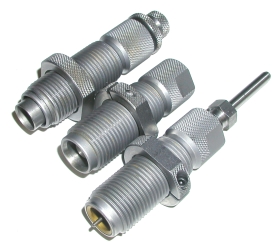
The 460 Rowland is handloaded with standard 45 ACP dies. I have been gradually making a transition from RCBS to Hornady die sets because of Hornady’s superior approach to bullet seating; a floating sleeve guides the unseated bullet into the die, assuring good alignment when seating, and a variety of seating stems properly contact the bullet ogive for uniform seating.
In addition to the 460 Rowland, the Hornady 45 ACP set also works for the 45 Auto Rim and 45 Winchester Magnum, so the three guys who shoot those cartridges are covered. The sizer die incorporates internal TiN, Titanium Nitride, plating in place of a more traditional carbide ring. This hard plated surface means no lube when sizing, virtually no wear and a smooth surface not prone to cracking or chipping. I still use RCBS shell holders because they fit my presses and APS priming system.
Bullet Seating Depth
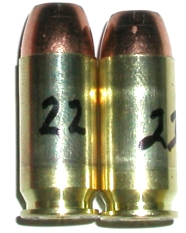
The 460 Rowland headspaces on the case mouth, so no crimp was used. The case on the right illustrates how undersize the case is made in the sizer die and why it has such a heavy duty grip on the bullet. Case mouths were barely expanded.
Left, same cases and bullets, however, the case on the right contains Hodgdon Long Shot and utilizes load data from the Hodgdon site. Where bullets of the same weight varied in length from one manufacturer to another, I wasn’t so much concerned with the effect of jacket and lead core hardness on load pressure, as much as I was about maintaining the same net case capacity from one bullet type to the next. I compared the referenced load bullets to the substitute bullet and made sure I maintained the same net case capacity when establishing seating depth for each. I felt this would bring me close to uniform pressures from common powder charges. The issue of seating depth is significant with the 460 Rowland, again, because of the high pressure operating end of the spectrum the round occupies. A load could move up from 38,000 PSI to 51,000 PSI by seating a bullet in a particular combination 0.075″ deeper. The length of 5 different 185 grain bullets from various manufacturers ran: 0.0500″, 0.543″, 0.645″, 0.540″, 0.550″ – clearly is would not be prudent to borrow load data from one and apply it to all of the others.
Bullet Selection

The full list of bullets I selected for this work up are, from left to right:
-
185 Grain Remington Golden Saber
-
185 Grain Remington Jacketed Hollow Point
-
185 Grain Sierra Sports Master
-
185 Grain Speer Gold Dot
-
200 Grain Speer Jacketed Hollow Point
-
200 Grain Hornady HP/XTP
-
230 Grain Hornady HP/XTP
-
260 Grain Speer Jacketed Hollow Point
I don’t know if these represent the optimal bullet choices for this round. I use 185 grain bullets quite a bit in standard ACP and +P loads and sometimes with Super level loads. The 460 Rowland, with its higher velocity potential, might be better served if fed heavier bullets. Speer, as an example, suggested their 260 grain bullet might be a better selection than their 185 grain bullet for use in the Rowland application. They felt the 185 grain bullet might excessively expand and/or over penetrate. In short, the Rowland’s benefit for practical use my be in its ability to push heavy bullets to a much higher than standard ACP velocity, rather than squeezing 1500 fps performance out of light 185 grain bullets. I am not an expert on handgun loads intended for defense against human interlopers with malicious intent or for law enforcement applications, but I would hazard a guess the Rowland may not be a round that is particularly suited for those purposes. I think the 460 Rowland makes for a great gun to carry in the woods as a backup while hunting, and I am pretty sure it would make a good hunting piece for tough pig size game.
The Kimber has no appreciation for cartridges with an overall length greater than 1.250″ in anything with a hollow point and truncated snout. Round tip bullets have a little more latitude. The short COL is not a limiting factor as there was plenty of case capacity for maximum loads within the powder selected.
Range – Shooting Impressions
The converted Kimber chewed the bullseye out of targets and routinely grouped 1.0 to 1.5″ at 25 yards shooting off of a sandbag rest while wearing three kinds of eyeglasses; the gun clearly out shot the operator. The compensator did a great job keeping the muzzle down and directing recoil straight back. The result was accurate shot placement and a little arm and shoulder stiffness at the end of the day. I did try standard 45 ACP ball ammo loads in the 460 Rowland chamber. Discharge was normal, accuracy actually wasn’t bad, but the gun burped only and did not cycle; too much compensator and recoil spring. The exercise did contrast the difference between the two rounds as the ACP round felt like a pop gun going off after shooting 20 or 30 rounds of the Rowland cartridge.
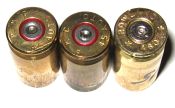 Expended cases exhibited some degree of primer flow, about the same as the standard ACP ball ammo loads. Case heads got beaten up a bit, some extractor marked, some ejector marked. No case failures or bulges in unsupported areas; cases measured about 1/16″ up from the extractor groove were 0.478″ in diameter after firing, the same as the standard velocity 45 ACP ball loads I fired. This dimension also applies to the round with the hammered rim described below.
Expended cases exhibited some degree of primer flow, about the same as the standard ACP ball ammo loads. Case heads got beaten up a bit, some extractor marked, some ejector marked. No case failures or bulges in unsupported areas; cases measured about 1/16″ up from the extractor groove were 0.478″ in diameter after firing, the same as the standard velocity 45 ACP ball loads I fired. This dimension also applies to the round with the hammered rim described below.
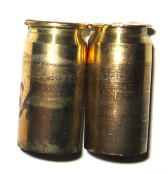 This condition was pretty exciting, but a singular and not clearly explainable occurrence. The case head on the right was hammered to 0.017″ thickness, down from the typical 0.048″~0.050″ for the new and once fired Starline brass. This was a relatively mild load and I could find no correlation between high pressure and velocity and fired cartridge rim thickness. I have to believe this wasn’t a manufacturing defect because all cases were trimmed and measured for case length and finished COL. So in conclusion I can definitely say, I have no idea what happened here, but it surely did not happen again.
This condition was pretty exciting, but a singular and not clearly explainable occurrence. The case head on the right was hammered to 0.017″ thickness, down from the typical 0.048″~0.050″ for the new and once fired Starline brass. This was a relatively mild load and I could find no correlation between high pressure and velocity and fired cartridge rim thickness. I have to believe this wasn’t a manufacturing defect because all cases were trimmed and measured for case length and finished COL. So in conclusion I can definitely say, I have no idea what happened here, but it surely did not happen again.
I had two stove pipe jams and it was pretty routine for the slide not to lock open on an empty magazine. In all fairness, these loads varied greatly and COL in many cases were well out of practical spec for the Kimber. With ammo utilizing uniform components and slightly less than maximum loads, the gun dumped empties a few feet away making brass recovery a snap. Light loads ended up at my feet, leaving me with the sense the springing was a little heavy. At some point in time I may want to go back and reduce the recoil spring rate a bit, and reinstall my Sprinco guide rod system. I view all of this as quite normal for tuning to a specific load, particularly one at this far end of the pressure range.
Some of the velocity readings were a little ragged, inconsistent with the same powder and only slightly different charges. I don’t know if this is a phenomena associated with subjecting powder designed and tested primarily for low pressure shotgun loads to high pressure metallic cartridge conditions, or if there is some other issue related to my mechanical assembly. Velocity variations did not suggest excessive pressure as much as they indicated a drop in velocity greater than one would expect with a very modest charge reduction. These loads were omitted from the handload data I published for this round. I might have gotten better uniformity with magnum pistol primers, or even with a tapered crimp. I know the 45 Long Colt is sensitive to crimping for proper ignition with heavy charges. The most inconsistent powder with the greatest velocity variation per tenth grain of powder was Hodgedon Long Shot, the most predictable performance came from Alliant Power Pistol and True Blue. Accurate AA #7 performed OK, none were really terrible. There are enough benefits in this cartridge – gun combination to iron out these small bugs and standardize on a few good loads. Of course, if you want to shoot the combination and don’t want the grief associated with handloading, there is the option of shooting factory loaded ammo that will deliver very high levels of performance. Personally, I find handloading to be more than half the fun of shooting and I like the expanded selection of components afforded by the process.
Summary
My intention is not to present the 460 Rowland in a negative light; quite the opposite. Conditions I noted are all minor and items routinely encountered in adjusting to a new performance firearm. The 460 Rowland is an interesting cartridge with a lot of potential. It is very accurate, very powerful and reliable with good ammo. The Clark Custom Gun’s kit is nicely made and well thought out by people who obviously know what they are doing. From a cost standpoint, it is a value, both kit and finished guns and ammo.
More “The 460 Rowland…Whoa Mama!”:
The 460 Rowland…Whoa Mama! Part 1
The 460 Rowland…Whoa Mama! Part 2 – Conclusion
460 Rowland handload Data
Thanks,
Joe

Email Notification